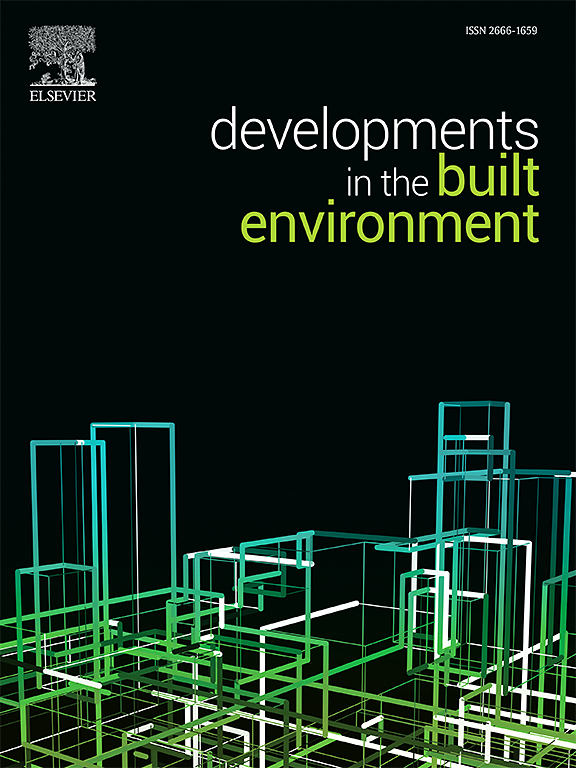石灰石煅烧粘土水泥(LC3)的流变学、力学性能和微观结构表征与可持续轻量化自密实混凝土
IF 6.2
2区 工程技术
Q1 CONSTRUCTION & BUILDING TECHNOLOGY
引用次数: 0
摘要
近年来,人们对使用环保建筑材料实现零排放目标的可能性越来越感兴趣。值得注意的是,混凝土行业利用许多替代品作为建筑部门发展的补充胶凝材料(scm)。随着时间的推移,这些材料的完整性有可能改变新混凝土的流变特性,使其易于发生化学反应。石灰石煅烧粘土水泥(LC3)和轻质膨胀粘土骨料(LECA)的物理化学行为,为研究目标强度为25 MPa的新型轻质自密实混凝土(LWSCC)的材料特性(包括流变特性)提供了重要信息。混凝土在动态运动下的易流动性主要由触变性和流变参数决定。其次,完美的流动模型对于确定混合料中非线性的变化至关重要,从而导致剪切增稠。因此,利用同轴叶片流变仪,借助Reiner-Riwlin (R-R)方程,通过坍落度流动、l -盒、u -盒、V漏斗和剪切流动曲线试验,确定了整体流变特性。Herschel-Bulkley (H-B)和修正Bingham (M -B)方程在数值上验证了非线性,流动指数(n)在1.52 ~ 1.79之间,c/μ >0。优化LWSCC混合料;在低剪切速率下,由于偏高岭土的水化加速和表面电荷的作用,动态屈服应力变化了20%,塑性粘度增加了25%。研究发现,在低剪切速率下,絮凝和颗粒减缓的程度决定了粘合剂中颗粒的相互作用。此外,鲜密度显著降低35%(与对照混合物相比)和通过瞬态法测量的导热系数解释了非均相LC3体系中硅酸盐层的各向异性结构效应。利用扫描电镜(SEM)研究了次生水化硅酸钙(C-S-H)、偏高岭土的化学相互作用和界面过渡区(ITZ)的作用。最后,具体能源评估和成本分析表明,二氧化碳(CO2)排放和成本分别减少了近16%和13%,从而朝着可持续的全球净零排放迈进了一步。本文章由计算机程序翻译,如有差异,请以英文原文为准。

Rheology, mechanical properties and microstructure characterization of limestone calcined clay cement (LC3) incorporated sustainable lightweight self-compacting concrete
In recent years, there has been growing interest in the possibility of achieving zero-emission goals using environmentally friendly building materials. Significantly, the concrete industry utilizes numerous alternatives as supplementary cementitious materials (SCMs) for development in construction sector. The integrity of these materials has the potential to alter the rheological properties of fresh concrete with ease of their chemical reactivity over time. The physico-chemical behavior of limestone calcined clay cement (LC3) and lightweight expanded clay aggregate (LECA) provides significant information about the intrinsic material characteristics including rheological attributes, of novel lightweight self-compacting concrete (LWSCC) of a target strength of 25 MPa. Primarily, the ease of flow in concrete is governed by the thixotropy and rheological parameters under dynamic motion. Secondarily, the perfect flow model is essential for determining the change in non-linearity in the mixes, leading to shear thickening. Therefore, the overall rheological behavior was determined through slump flow, L-box, U-box, V funnel, and shear flow curve tests using a coaxial vane rheometer with the help of Reiner-Riwlin (R-R) equations. Herschel-Bulkley (H-B) and Modified Bingham (M − B) equations numerically validates non-linearity with flow index (n) ranging between 1.52 and 1.79 with c/μ >0. For optimized LWSCC mix; the dynamic yield stresses varied by 20% owing to hydration acceleration and surface charge of metakaolin with an increase in plastic viscosity by 25% under low shear rate. It was found that the extent of flocculation and particle mitigation governs particle interactions in binders at low shear rates. Moreover, the significant reduction in fresh density by 35% (as compared to control mix) and the measurement of thermal conductivity through transient-state method explain the anisotropic structure effect of silicate layers in the heterogeneous LC3 system. A Microstructure study was employed to understand the contribution of secondary calcium silicate hydrate (C-S-H), chemical interaction of metakaolin, and interfacial transition zone (ITZ) through scanning electron microscopy (SEM). Finally, embodied energy assessment and cost analysis showed reduction in carbon dioxide (CO2) emission and cost by nearly 16% and 13%, respectively, leading to a step toward global net zero emission with sustainability.
求助全文
通过发布文献求助,成功后即可免费获取论文全文。
去求助
来源期刊

Developments in the Built Environment
Multiple-
CiteScore
7.40
自引率
1.20%
发文量
31
审稿时长
22 days
期刊介绍:
Developments in the Built Environment (DIBE) is a recently established peer-reviewed gold open access journal, ensuring that all accepted articles are permanently and freely accessible. Focused on civil engineering and the built environment, DIBE publishes original papers and short communications. Encompassing topics such as construction materials and building sustainability, the journal adopts a holistic approach with the aim of benefiting the community.
 求助内容:
求助内容: 应助结果提醒方式:
应助结果提醒方式:


